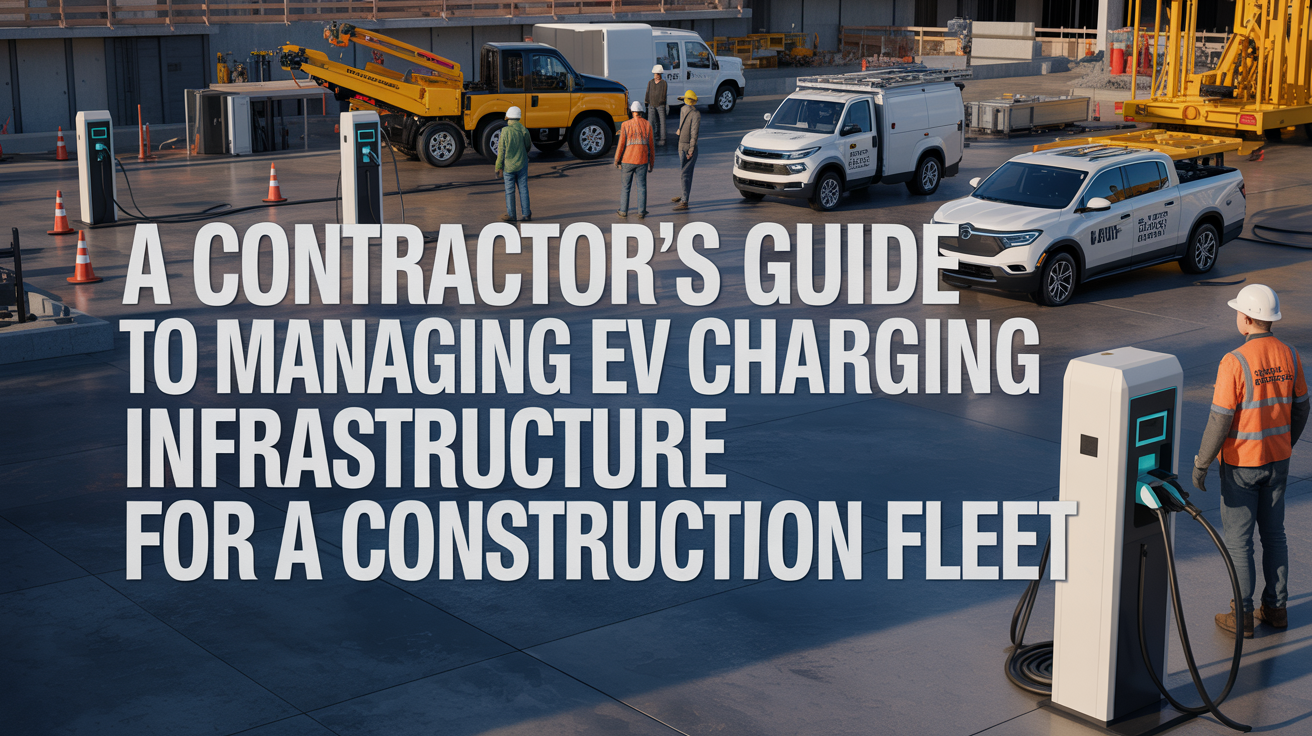A Contractor’s Guide to Managing EV Charging Infrastructure for a Construction Fleet
Introduction
The construction industry is embracing electric vehicles (EVs) as part of its efforts to modernize fleets and reduce carbon footprints. 🚧✨ Contractors are increasingly adopting EVs, but this shift requires robust EV charging infrastructure to keep operations running smoothly. Without proper planning, contractors risk inefficiencies and costly disruptions. This guide aims to equip construction contractors with the knowledge they need to manage EV charging infrastructure effectively. By the end, you’ll understand how to implement practical steps, overcome common challenges, and optimize fleet operations.
Whether you’re just starting to explore EV adoption or looking to refine your existing setup, this article will provide actionable insights. From assessing site requirements to future-proofing your system, we’ll cover every step of the process. Let’s dive in and discover how you can make EV charging work seamlessly for your construction fleet. 🌟
Understanding Fleet Electrification for Construction Contractors
Fleet electrification refers to the transition from traditional fuel-powered vehicles to electric alternatives. For construction contractors, this shift is driven by stricter emissions regulations, rising fuel costs, and growing environmental awareness. 💡⚡ EVs offer significant operational benefits, such as lower maintenance costs and quieter operation, which are ideal for urban construction sites. Additionally, adopting EVs positions contractors as leaders in sustainability, enhancing their reputation and competitive edge.
Beyond operational advantages, EV adoption also brings financial and environmental rewards. Lower fuel expenses and government incentives help offset initial investment costs. Plus, reducing greenhouse gas emissions aligns with global climate goals. As more contractors embrace fleet electrification, understanding its benefits becomes crucial for staying ahead in the industry. Now, let’s explore how to assess your site’s specific needs to support this transition. 📋
Assessing Site Requirements and Charging Needs
Before installing EV charging infrastructure, a detailed site assessment is essential. This involves evaluating available space, electrical capacity, and optimal locations for charging stations. Identifying these factors ensures that your site can handle the additional load and integrates seamlessly into daily operations. 🏗️🔍 Proper siting minimizes disruptions and maximizes efficiency, making it a critical first step.
Next, consider the number and types of vehicles in your fleet, as well as their daily mileage and downtime for charging. These variables influence the type and quantity of chargers needed. For example, heavy-duty vehicles may require faster chargers than lighter trucks. Understanding these nuances helps tailor the infrastructure to your fleet’s unique demands. With this data, you can create a plan that supports both current and future needs. 🚛🔋
Finally, initial assessments play a key role in shaping the design and scalability of your charging infrastructure. They ensure that your system can grow alongside your fleet, avoiding costly retrofits later. By addressing potential bottlenecks early, you set the stage for a smooth and efficient deployment. Transitioning to the next phase, let’s examine the types of EV chargers available and how to choose the right ones for your fleet. ⚙️
“The first step in EV implementation is conducting a thorough on-site assessment. This should always include meeting with key fleet and operations personnel to confirm that the site can support EV charging and that the site layout has adequate space for ingress, egress, and charging lanes without interruption to daily fleet operations.”-PowerFlex
Types of EV Chargers and Selecting Suitable Equipment
There are three main types of EV chargers: Level 1, Level 2, and DC Fast Chargers. Level 1 chargers are the slowest, using standard household outlets, while Level 2 chargers offer faster charging and are ideal for overnight use. DC Fast Chargers provide rapid charging, perfect for vehicles with limited downtime. Each type has its own applications, depending on your fleet’s needs. 🔌⚡
“Evaluate charging equipment options and determine your overall financials… Use resources like the California Energy Commission’s Electric Vehicle Charger Selection Guide tool.”-Department of Energy
Selecting the right charger models involves considering your fleet size, usage patterns, and charging windows. For instance, if your vehicles return to the depot nightly, Level 2 chargers might suffice. However, if quick turnarounds are necessary, DC Fast Chargers could be worth the investment. Balancing speed, cost, and utility rates is key to making informed decisions. 📊💡
“Site assessments also assist fleet facilities in understanding if they have the electrical capacity to power EV chargers… if an upgrade in service is necessary, the provider will contact the utility to begin creating upgrade timelines and calculating the potential costs.”-PowerFlex
To future-proof your equipment choices, opt for modular and scalable solutions. Choose chargers compatible with emerging technologies and multiple vehicle types. This flexibility ensures your infrastructure remains relevant as EV models evolve. With the right equipment in place, the next step is upgrading your electrical infrastructure to support these systems. 🔧⚡
“Designing your fleet’s EV charging infrastructure for scalability includes proper hardware choices and sizing, data management software flexibility, options to include clean energy sourcing, and staying current with a dynamic and evolving regulatory environment.”-PowerFlex
Electrical Infrastructure Upgrades and Utility Coordination
Upgrading electrical infrastructure is often necessary to accommodate EV charging stations. This may involve increasing transformer capacity, upgrading panels, or improving power delivery systems. Conducting a thorough review ensures your site can handle the increased load without compromising safety or performance. ⚡🛠️ Collaborating with licensed electricians and engineers is crucial during this phase.
“Installing fixed charging stations often takes months or even years of permitting, construction, and coordination.”-SparkCharge
Working closely with utilities and regulators is equally important. They can help secure adequate grid power, navigate permitting processes, and ensure compliance with local codes. By building strong relationships with utility providers, you can access valuable resources and support. With your electrical upgrades in place, the next step is designing an efficient depot layout to integrate charging seamlessly. 🏭🚗
“An integrated fleet charging and telematics platform allows fleet managers to create efficient charging schedules… Charging can also be scheduled to coincide with off-peak utility rates, improving economics.”-PowerFlex
Designing Depot Layouts and Onsite Operations
An effective depot layout prioritizes charger placement, vehicle flow, and safety. Chargers should be strategically located to minimize travel time and avoid congestion. Clear signage and designated zones improve efficiency and reduce accidents, ensuring smooth operations even during peak hours. 🚧🚨 Thoughtful planning reduces disruptions and enhances productivity.
“While training might be expensive, it means your employees understand the systems more fully and carry out their duties safely and efficiently. If a site manager ignores or doesn’t understand certain information, it can cause catastrophic outcomes such as long site downtime, angry customers, or even business failure.”-Ampcontrol
In addition to physical layout, implementing intelligent monitoring systems and staff training programs is vital. Dashboards that track charging status and energy usage allow for real-time adjustments. Training employees on new protocols ensures everyone understands their roles in maintaining the system. With a well-designed depot, managing load and scheduling becomes easier. Let’s explore smart charging solutions next. 💻⚡
“For larger fleets, the electrical capacity to support the additional energy load of EV chargers may require upgrades to transformers, equipment, or service. These upgrades can extend timelines for project completion and could be costly if incentive programs aren’t leveraged.”-PowerFlex
Managing Load, Scheduling, and Smart Charging Solutions
Load management strategies are essential for optimizing EV charging. Scheduling charges during off-peak hours not only reduces strain on the grid but also lowers utility costs. Integrating telematics provides insights into vehicle usage patterns, enabling smarter scheduling decisions. 🕒📊 These practices enhance efficiency and save money.
“EV fleets should choose an EV charging provider that is experienced in evaluating all available incentives and grants, including utility make-ready programs that would reduce capital costs for EV infrastructure.”-PowerFlex
Centralized software dashboards simplify fleet management by streamlining operations and providing real-time updates. Monitoring tools alert operators to issues like overloads or equipment failures, allowing for quick resolutions. With these systems in place, contractors can focus on cost management and funding opportunities. Let’s discuss how incentives can offset upfront expenses. 💰🌱
“A charging plan will set a schedule for your fleet’s charging to ensure all vehicles have enough power to complete their required tasks. Work with your utility and equipment vendor to develop a plan suitable for the vehicle type.”-Department of Energy
Cost Management, Incentives, and Funding Opportunities
While the upfront costs of EV charging infrastructure can be substantial, various incentives and funding programs are available to ease the burden. Expenses include equipment, installation, electrical upgrades, and civil works. However, rebates, tax credits, and grants can significantly reduce these costs. 🏦💸 Evaluating long-term ROI is crucial for making informed financial decisions.
“Designing your fleet’s EV charging infrastructure for scalability includes… options to include clean energy sourcing, and staying current with a dynamic and evolving regulatory environment.”-PowerFlex
Federal, state, and local governments, along with utility companies, offer programs to support EV adoption. Researching these opportunities ensures you maximize savings and leverage available resources. With funding secured, the next step is deploying your infrastructure through a structured process. Let’s outline the typical construction timeline. 📅🏗️
Deployment Process: Construction, Testing, and Commissioning
The deployment process begins with obtaining permits, followed by installation, trenching, and commissioning. Each phase requires careful coordination to meet deadlines and adhere to safety standards. Permitting delays can extend timelines, so proactive communication with authorities is essential. 📋🚧 Once installed, chargers undergo rigorous testing to ensure functionality and compliance.
Safety checks and operational verification are the final steps before going live. Inspectors confirm that all equipment meets specifications and operates safely under load. With the system commissioned, ongoing operations and maintenance become the focus. Let’s discuss how to sustain long-term performance. 🔧✅
Ongoing Operations, Maintenance, and Support
Maintaining EV charging infrastructure involves routine tasks like inspections, software updates, and technical support. Regular maintenance prevents downtime and extends equipment lifespan. Monitoring battery health and scheduling preventive care ensures consistent performance. 🛠️🔋 Staying proactive minimizes disruptions and keeps your fleet running smoothly.
Technical support teams play a vital role in addressing issues quickly. Partnering with reliable providers guarantees timely assistance when problems arise. With solid maintenance practices in place, addressing common challenges and future-proofing your fleet becomes achievable. Let’s explore strategies for overcoming obstacles and adapting to growth. 🌱🚀
Addressing Common Challenges and Future-Proofing Your Fleet
Implementing EV charging infrastructure comes with challenges, including long lead times, permitting delays, and scaling limitations. These hurdles require patience and strategic planning to overcome. Proactive measures, such as engaging stakeholders early, can mitigate risks and streamline the process. 🚧⏳ Planning for future growth ensures your system remains adaptable as your fleet expands.
To stay ahead, contractors should regularly evaluate emerging technologies and adjust their strategies accordingly. Investing in flexible, modular systems allows for easy upgrades and integration with new vehicle models. By anticipating changes and preparing for them, you position your fleet for long-term success. Next, let’s summarize best practices and regulatory trends shaping the industry. 📈🌍
Best Practices, Emerging Trends, and Regulatory Considerations
Best practices for EV charging infrastructure include thorough planning, collaboration with experts, and leveraging technology. Efficient deployment hinges on integrating charging systems with fleet management tools, ensuring seamless operations. Staying informed about regulatory trends helps contractors comply with evolving standards and capitalize on opportunities. 📜🌐
Regulatory considerations, such as emissions mandates and utility policies, shape the landscape of EV adoption. Keeping abreast of these developments ensures compliance and maximizes benefits. As EV technologies continue to evolve, staying agile and informed is crucial for sustained success. Now, let’s address some frequently asked questions about managing EV charging infrastructure. ❓📝
Frequently Asked Questions (FAQ)
What initial steps should contractors take before installing EV charging infrastructure for their fleet? Begin with a comprehensive site assessment to evaluate space, electrical capacity, and vehicle needs. Engage with utilities and stakeholders early to align expectations and secure support.
How can contractors determine the right number and type of chargers for their specific needs? Analyze fleet size, daily mileage, and charging windows to identify appropriate charger types and quantities. Consult with experts to validate your choices.
What are the most common challenges encountered during EV charging infrastructure deployments? Long lead times, permitting delays, and scaling limitations are frequent obstacles. Address these proactively through careful planning and stakeholder engagement.
Are there any incentives or funding programs available for contractors investing in EV fleet charging? Yes, federal, state, and local programs, along with utility rebates, can offset costs. Research available options to maximize savings.
How can contractors ensure their EV charging system remains scalable and future-proof? Opt for modular designs and stay informed about emerging technologies. Regularly reassess your infrastructure to adapt to changing needs.
Conclusion
Strategic planning and collaboration are the cornerstones of successful EV charging infrastructure deployment for construction fleets. By following the steps outlined in this guide, contractors can achieve operational efficiency, financial savings, and environmental sustainability. From site assessments to ongoing maintenance, each phase contributes to a robust and scalable system. 🚧🌟
Begin with a pilot program to test the waters, thoroughly assess your site, and engage utility partners and technology providers. These actions pave the way for long-term success and cost savings. Key takeaways include the importance of assessment, designing for scalability, leveraging incentives, and prioritizing ongoing management. Start today, and position your fleet for a greener, more efficient future! 🌍⚡



